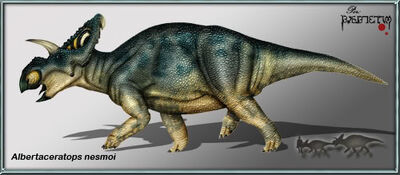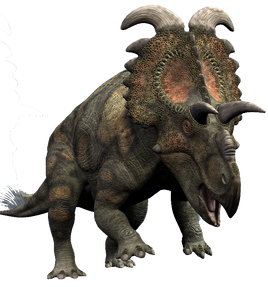

Albertaceratops (meaning "Alberta horned face") was a genus of centrosaurine horned dinosaur from the middle Campanian-age Upper Cretaceous Oldman Formation of Alberta, Canada. Albertaceratops is known from a single complete skull (TMP.2001.26.1) found in August 2001 and skull and postcranial fragments. This genus is unusual in combining long brow horns with an otherwise centrosaurine skull, as centrosaurines normally possess short brow horns. Over its nose was a bony ridge, and on its frill were two large outwardly-projecting hooks. A phylogenetic analysis carried out by its describer, Michael J. Ryan, found it to be the most basal centrosaurine. Additional specimens were reported from a bonebed in the Judith River Formation of Montana, which is equivalent to the Oldman Formation and differentiated only by the United States/Canadian border. However, further study showed these remains to come from a chasmosaurine, Medusaceratops. Both ceratopsids lived during the same time period, about 77.5 million years ago.
The specific name, A. nesmoi, is derived from the name of Cecil Nesmo, a rancher living in Manyberries, Alberta, a town of less than 100 people located 71 km south of Medicine Hat. The rancher was thus honored in recognition of his efforts to aid fossil hunters.
Description[]
Albertaceratops is unusual in combining long brow horns with an otherwise centrosaurine skull, as centrosaurines normally possess short brow horns. Over its nose was a bony ridge, and on its frill were two large outwardly-projecting hooks. Its size has been estimated at 5.8 metres (19 ft) and 3,500 kilograms (7,700 lb).
Discovery and naming[]
Albertaceratops is known from a single complete skull (TMP.2001.26.1) found in August 2001 and skull and postcranial fragments. A phylogenetic analysis carried out by its describer, Michael J. Ryan, found it to be the most basal centrosaurine. Additional specimens were reported from a bonebed in the Judith River Formation of Montana, which is equivalent to the Oldman Formation and differentiated only by the Canada–US border. However, further study showed these remains to come from a different centrosaurine, Medusaceratops. Both ceratopsids lived during the same time period, about 77.5 million years ago.
The specific name, A. nesmoi, is derived from the name of Cecil Nesmo, a rancher living in Manyberries, Alberta, a town of less than 100 people located 71 km south of Medicine Hat. The rancher was thus honored in recognition of his efforts to aid fossil hunters.
In popular culture[]
- Albertaceratops appears as a playable dinosaur in Path of Titans
- Albertaceratops appears in Dinosaur King